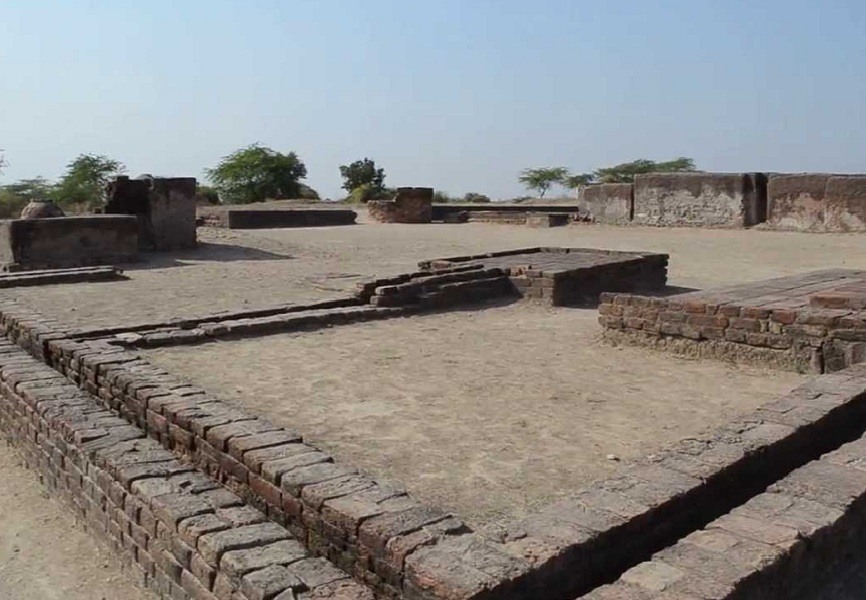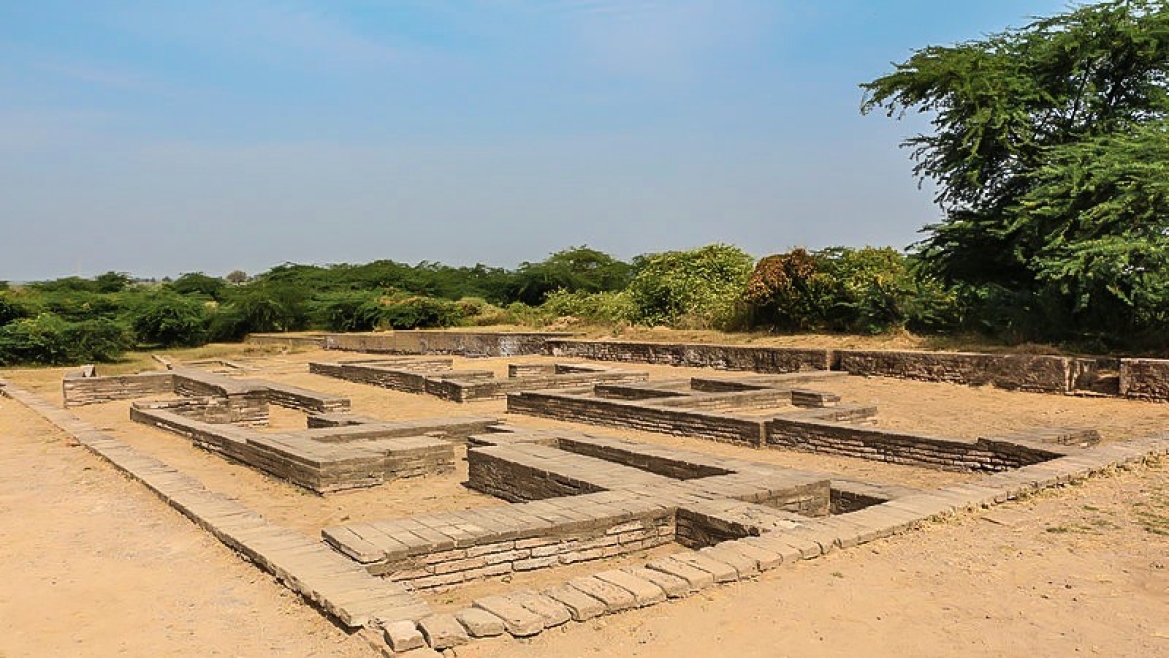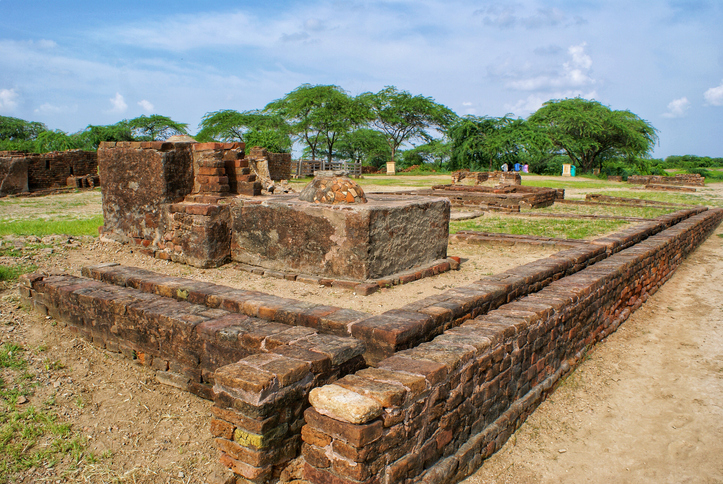Lothal, Dist.Ahmedabad is situated near the village of Saragwala in the Dholka Taluka ofAhmedabad. Located in the modern state of Gujarat and dating from 2400 BC it is one of India’s mostimportant archaeological sites that date from that era. Discovered in 1954, Lothal was excavatedfrom 1955 to 1960 by the Archaeological Survey of India (ASI). Lothal‘s dock, the world’searliest, connected the city to an ancient course of the Sabarmati river on the trade route betweenHarappan cities in Sindh and the peninsula of Saurashtra when then surrounding Kutch desert oftoday was a part of the Arabian Sea. It was a vital and thriving trade centre in ancient times, withits trade of beads, gems and valuable ornaments reaching the far corners of Africa and Asia.


In 1930’s, following the discovery of remains of Indus Valley Civilization at Harappa and Mohen-jo-Daro; Chalcolithic studies came into being in Gujarat. The first excavated Chalcolithic site in Gujarat was Valabhipura (Anderson and Afonso 1990). It was followed by the excavation at Rangpur by M.S. Vats (1936: 34-38). The site was subsequently excavated by Ghurye (1939: 12) and Dikshit (1950: 35). The excavations at Rangpur and Lothal by S. R. Rao of the Archaeological Survey of India in 1950’s gave a new shape to the archaeological researches of Gujarat and subsequently became the focal point of Proto- Historic studies. Rao’s work in Gujarat has been carried forwarded by various Departments/Institutions namely Archaeological Survey of India; The Maharaja Sayajirao University of Baroda, Vadodara; The State Department ofArchaeology, Gujarat; Deccan Collage, Pune; and some foreign Universities/Individuals. Various researches by all these Departments/Institutions brought to light a plethora of data covering a time period of 3500 BC to 1000 BC with more than 750 sites belonging to various periods of Harappan Culture and regional Chalcolithic Cultures.
In the early stages of the Chalcolithic studies it was assumed that the earliest agricultural communities of Gujarat were associated with the Mature/Urban Harappan period (Sonawane 2000: 137-146). Re-analysis of cultural materials from Surkotada, Prabhas Patan and Lothal and recent excavations conducted at Loteshwar, Dholavira and Padri has indicated that prior to the influence of the Harappan culture, Gujarat was already inhabited by regional non-Harappan Chalcolithic communities/ PreHarappans. Non-Harappan ceramics were reported from the earliest levels of these sites and continued upto late Harappan phase in different sites of Gujarat (Bhan 1994: 71-90). Calibrated radio carbon dates for this period from Loteshwar, Padri and Prabhas Patan goes back to the second half of the fourth and the beginning of third millennium BC (Sonawane 2000: 137-146). The evidence from Lothal suggests that the Chalcolithic people used Micaceous Red ware and Black and Red ware, which is different from the Harappan ceramics.
The excavations at Nagwada in the Rupen river valley have yielded the evidence of human burials, belonging to the Pre-Harappan period. The site also yielded pottery, which has similarities with the pottery from the earliest period (Pre Urban Harappan level) at Amri in Sindh and this pottery can be assignable to 3000-2600 BC (Dhavalikar 1995). Excavations at Datrana in North Gujarat has revealed different types of potteries i.e. a set of pottery similar to the Pre-Prabhas (3000-2800 BC) type, the Anarta/north Gujarat pottery type and the Early Harappan (Pre Urban Harappan) pottery reported from the burials at Nagwada and Santhli (Ajithprasad 2002: 129-158). All these reveal that there must have been indigenous population existed before the influence ofHarappan culture in Gujarat.

Archaeological studies of Gujarat revealed two distinct categories of settlements during the Mature/Urban Harappan phase. According to Possehl (Possehl 1992: 117- 154) these are the sites with Classical Harappan traits (Sindhi Harappan) and sites with regional manifestation (Sorath Harappan) ofthe Harappan domain respectively. It is notable that in more than seven hundred fifty sites in Gujarat with different degrees ofHarappan affiliation, settlements representing the Classical Harappan’s are few and most of these sites show some amount of Regional Chalcolithic influences. Some of the sites of the Mature/Urban Harappan phase were engaged in craft production and the.manufactured goods of these sites include items of semiprecious stones, faience, steatite, shell and copper. Some of these sites may have acted as trading centres. Sites like Lothal, Dholavira and Surkotada have revealed evidences of monumental architecture, social stratification, writing and developed artistic styles.
The Late/Post Urban Harappan period in Gujarat is represented by cultural periods Rangpur III, Prabhas Patan III and Rojdi C. Scholars defined this period on the basis ofthe increase in the frequency of pottery types like lustrous red ware, painted black and red ware and coarse ware (Bhan 1994: 71-90). The Mature/Urban to Late/Post Urban Harappan transformation is reflected in the lithic artifacts too. The inferior quality blades oflocal chert replaced the Sukur Rohri Chert blades (Sonawane 2000: 137-146). Deterioration in Mature/Urban Harappan settlement pattern is very clear and also supported by radio carbon dates. The Late/Post Urban Harappan can be dated to 1900-1400 B.C.
Among, more than seven hundred fifty sites reported in Gujarat, thirty nine are excavated. The excavated Chalcolithic sites in Gujarat are:
Kutch Desalpur (IAR 1963-1964), Dholavira (Bisht 1991: 71-82, 2004: 35-48), Juni Kuran (Pramanik 2003-2004: 45-67), Kanmer (Kharakwal et. al. 2005: 115-123), Pabumath (IAR 1965-1966), Shikarpur (IAR 1963-1964) and Surkotada (Joshi 1972: 98-144, 1990).
Saurashtra Amra (IAR 1955-1956), Babarkot (IAR 1955-1956, 1990-1991), Bagasra/Golo Dhoro (Sonawane et. al. 2003: 21-50; Bhan et. al. 2004: 153-158), Bet Dwarka (Gaur and Sundaresh 2003: 57-66), Bokhira (Gaur et. al 2006: 33-39), Kanewal (Mehta et. al 1980), Kuntasi (Dhavalikar et. al. 1996), Lakhabawal (Rao 1963: 1-250), Lothal (Rao 1979, 1985), Nageshwar (Hegde et. al 1990), Nesdi/Valabhi (Mehta 1984: 243-251), Oriyo Timbo (Rissman 1985; Reddy 1991: 79-81), Padri (Shinde 1992a: 79-86, 1992b: 55-86; Shinde and Kar 1992: 105-110), Pithad/Jaidak (IAR 1959-1960, 1990- 1991; Ajithprasad 2003), Rangpur (Rao 1963: 1-250), Rojdi (Possehl and Rawal 1989), Somnath/Prabhas Patan (Nanavati et. al 1971; Dhavalikar and Possehl 1992: 72-78) Vagad (Sonawane and Mehta 1985: 34-44) and Valabhipura (Anderson and Afonso 1990).
North Gujarat Datrana (IAR 1994-1995, 1995-1996), Loteshwar (IAR 1991-1992; Bhan 1994: 71- 90), Mathutra (Majumdar 1999), Moti Pipli (Majumdar and Sonawane 1996: 11-17), Nagwada (Hegde et. al. 1988: 55-65), Ratanpura (IAR 1984-1985; Bhan 1989: 219- 242), Santhli (IAR 1993-1994) and Zekhada/Jekhada (Momin 1983: 120-125).
South Gujarat Bhagatrav (Rao 1963: 1-250), Dhatwa (Mehta and Chaudhary 1975), Jokha (Mehta and Chaudhary 1971), Malwan (Rao 1963: 1-250) and Megham (Rao 1963:1-250). Ofthese, Lothal and Dholavira (Fig. 2.1) caught the attention of many archaeologists and non-archaeologists due to their architecture and variety ofmaterial remains. Apart from this Lothal is also famous for having the world’s first Dockyard whereas Dholavira is remarkable for its monumental structures, aesthetic architecture and water harvesting system
LOTHAL Lothal, “the mound ofthe dead” in the local vernacular, (Lat. 70° 14’ 25” N., Long. 20° 31 ’ 25” E.) is situated in the Saragwala village, Dholka Taluka of Ahmedabad district and is one of the well-known Harappan sites in India. Located 90 kilometer 79 southwest ofAhmedabad, in the alluvial plain of Bhogavo and the Sabarmati Rivers, it is reasonably a large mound, which rises gently to 8 meters above the ground. The excavations at the site in the 1950’s by S.R. Rao (1973, 1979 and 1985) not only established the emphatic presence of the southern most Harappan city but also revealed several unique features ofthe Indus civilization itself At Lothal the Classical Harappan artifacts recovered from the site includes steatite seals and terracotta sealings, cubical weights, semiprecious stone beads including etched camelian beads, chert blades, shell bangles and copper objects. A circular Persian Gulf type seal recovered from the site shows its overseas interaction. The pottery also showed all the essential shapes and painted decorative patterns of the Classical Harappan. But, in addition to these, the pottery incorporated vessels of the Sorath Harappan—Micaceous Red ware and Black and Red ware from the very beginning, probably indicating the influence ofindigenous strand at the site. A small cemetery with 25 burials has been found on the west of the city. Apart from the normal burials with pottery as burial goods, there are few double burials also, in which two skeletons were found. Although very rare, burial showing simultaneous inhumation of two bodies has also been reported from the early Harappan site at Santhli in north Gujarat.
Lothal draws heavy tourist traffic both domestic and international, irrespective of inadequate facilities. Lothal has a site museum displaying the unearthed antiquities from the site but this site-museum has to create more tourist friendly displays and interactive programs. Lothal has great potential for cultural tourism because visits can be coordinated through package tours with wild life tourism by including the nearby wild-life sanctuary. Soil erosion threatens the future ofthe site. The cemetery area is under thick vegetation which pause difficulty for the visitor to see the same.
www.tribaltoursinindia.com © All Rights Reserved, 2021